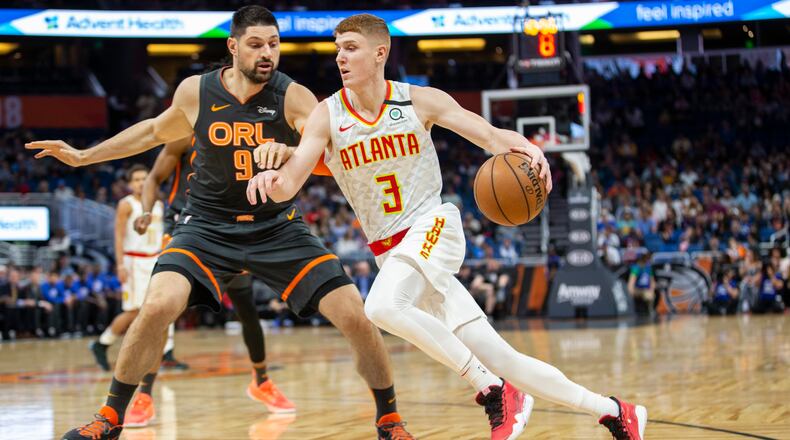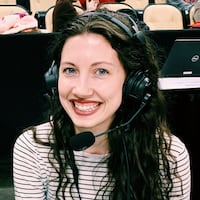Lloyd Pierce ran into Kevin Huerter’s dad, Tom, in one of Madison Square Garden’s tunnels in December 2018.
Huerter, who is from Clifton Park, New York, and was rookie at the time, had just gone 6-for-12 from the field and scored 16 points in the Hawks’ 114-107 win vs. the Knicks. The Hawks coach relayed a message to Huerter’s dad that still applies today.
“I said ‘Hey, Mr. Huerter. Tell your son to shoot more,’” Pierce said, laughing. “It shouldn’t happen that way. Coaches shouldn’t be able to tell the dads to tell their sons to shoot more. It’s usually the other way, you’ve got dads, parents telling the coach, ‘My son needs more shots.’ ”
But that’s what Pierce wants from the 6-foot-7, 21-year-old wing, who averaged 12.2 points, 3.8 assists and 4.1 rebounds in his second season with the Hawks (although 15 games are still outstanding, with the NBA season suspended because of the coronavirus). Huerter shot 41% from the field and 38% from 3-point range this season and is one of the “Core Five” players the Hawks are rebuilding around, along with Trae Young, Cam Reddish, De’Andre Hunter and John Collins.
“That’s really a testament to his skill set,” Pierce said. “We need him to be that lethal, knock-down shooter because it opens not only opportunities for him but for other guys.”
With his shooting and size, the Hawks see a huge amount of potential in Huerter, but injuries muddled Huerter's sophomore campaign. He started the year with a right knee injury, which had been nagging him since the beginning of the offseason, and didn't look fully like himself until mid-November. Then, playing against the Nuggets Nov. 12, he injuried his left shoulder on a foul by Nikola Jokic, with Jokic bumping his left arm as Huerter was making a throwing motion across his body. He missed 11 games and returned Dec. 4, but it was another two weeks or so before Huerter looked comfortable again. He surged in January and February after putting injuries behind him.
Pierce sees Huerter as someone who can get up to 40% from 3, which is Huerter's specialty, although he's shown his passing ability as well, stepping up in games when Young was out. He also wants to see more shot attempts: Huerter, who started 48 of his 56 games played, had 10.9 field-goal attempts per game this season, with six of those 3-point attempts.
“When you have that kind of player, that kind of shooter, that capability, you always want to increase the number of attempts that he gets,” Pierce said. “I was always challenging him. Sometimes you have to take contested 3’s to be really good. Sometimes you have to work a little bit harder to make defenders chase you, because you’re that good of a shooter. It’s an unintended consequence, when he does that, when he’s looking to shoot that often, when he’s moving that much off the basketball as a shooter, he’s going to create more opportunities not just for himself, but for other guys. So we’re encouraging him.”
Huerter entered his second season with the Hawks wanting to add another layer to his game, aiming to become more aggressive and improve at finishing through contact. That would also also get him to the free-throw line more, something that’s been lacking in his game (he averaged 0.7 free-throw attempts as a rookie and 1.1 this season).
Although he improved from his rookie season, injuries held him back from that goal, and he often looked hesitant.
Hawks general manager Travis Schlenk recently said he saw Huerter become more of a professional when it came to staying on top of body maintenance and injuries, after getting behind with that going into the year.
“Because of his injury earlier in the season, the knee stuff that he quite frankly didn’t stay on top of during the summer, we kind of ask everybody to stay here until summer league and we ask them to go out to Vegas for a while, and then we give them July and August to go back home, train at home. … He came back in end of August, first of September, and he was in worse shape and his knee was bothering him,” Schlenk said.
Moving forward, Schlenk wants to see Huerter become a more aggressive player, particularly when he’s at mid-range or closer.
“His biggest thing is he has to play more confidently,” Schlenk said. “He’s so talented, he’s such a good shooter. He’s really good at getting in the lane and shooting that, it’s not really a floater for him, it’s more of just a little stop and pull-up. He’s got more athleticism than people think, and because he’s 6-foot-7, he shoots that over guys. That’s a very effective shot for him. But he’s hesitant to go to that. Just the growth in him as professional, and then hopefully we see, I don’t think it’s a confidence issue, I just think it’s an aggressive issue with him, and hopefully we’ll see that growth on the floor where he becomes more aggressive.”
About the Author
Keep Reading
The Latest
Featured



